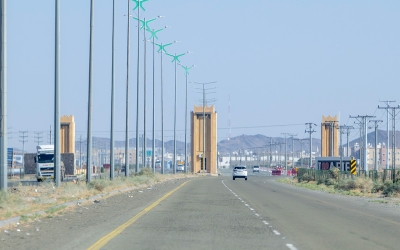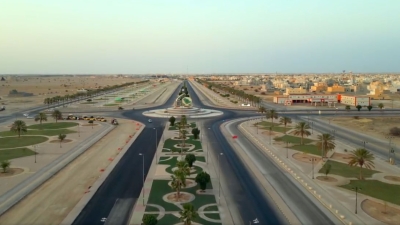
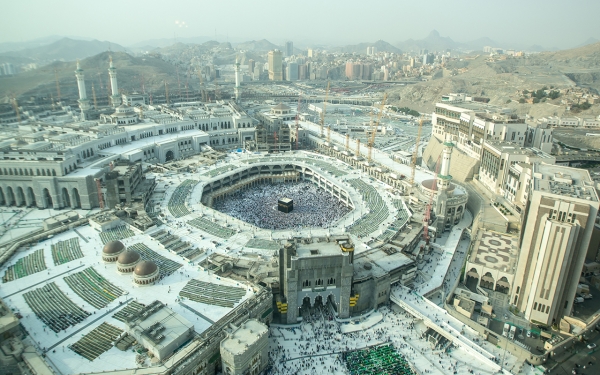
Makkah al-Mukarramah City (romanized: Makkat al Mukarramah), located in the western region of the Kingdom, serves as the administrative capital of Makkah al-Mukarramah Province. It stands as one of the oldest cities globally, bearing significant religious importance for Muslims, who constitute about one-fifth of the global population. It has been a continuous religious destination since ancient times, predating Islam. It is home to al-Kaabah al-Musharrafah, towards which Muslims pray, and the Grand Mosque. Moreover, it encompasses the holy sites and is the birthplace of the Prophet Muhammad, peace be upon him (PBUH). It was here that the Quran was revealed, marking the inception of the call to Islam.
For religious and urban considerations, Makkah al-Mukarramah City boasts multiple legislative and administrative structures. Administratively, it falls under the jurisdiction of Makkah al-Mukarramah Province, alongside sixteen other governorates. Its governor serves as the advisor to the Custodian of the Two Holy Mosques, Prince Khalid al-Faisal Bin Abdulaziz Al Saud. It is one of the provinces in the Kingdom developed by the Royal Commission for Makkah City and the Holy Sites, chaired by the Crown Prince and Chairman of the Council of Ministers, His Royal Highness Prince Mohammed Bin Salman Bin Abdulaziz. The Municipality of the Holy Capital oversees the administration of municipal affairs in Makkah. The Ministry of Hajj and Umrah, in collaboration with several governmental entities, oversees the management and care of Hajj pilgrims and Umrah performers.
Makkah al-Mukarramah City represents a spiritual center and the cradle of celestial religions. It has been a pilgrimage site in Islam since 631, renowned for its association with prophetic stories and Quranic revelations. It houses the Grand Mosque, which, according to the Quran, is the first house established for mankind. In its religious significance, it represents a crucial economic driver in the Kingdom, as it is earmarked under one of the programs of Saudi Vision 2030. The Kingdom aims to host thirty million Hajj and Umrah pilgrims by 2030. The Kingdom maintains its religious institutions there, and Makkah al-Mukarramah houses the headquarters of the Organization of Islamic Cooperation, representing the union of Muslims from around the world. It also hosts Islamic summits and conferences at the level of heads of state and ministers.
A historical overview of Makkah al-Mukarramah City
Designation of Makkah al-Mukarramah
Makkah al-Mukarramah City has several names, including Umm al-Qura, al-Haram, al-Balad al-Amen, and al-Balad al-Amin. As for Bakkah, it is the location of the Kaaba within the Grand Mosque, and it houses the Zamzam well, whose water has been flowing for over four thousand years. It is one of the oldest cities in the world, mentioned in ancient Greek, Syriac, and Roman sources. In Syriac, it means 'Makrabo', in Assyrian 'Makkah', and in ancient Sabaean 'Makraba', all of which means 'the holy city'. Additionally, Makkah al-Mukarramah retains the oldest boundary demarcation to date, with marks reaching 1,104 markers.
Traditional architecture in Makkah al-Mukarramah
The traditional buildings in the city of Makkah al-Mukarramah are distinguished by a unique architectural style in terms of shape, construction method, and materials used. The people of the Hijaz continued to name their houses the Hijazi house until the fourteenth century, celebrating the remaining art of Islamic architecture that reached its peak in the eleventh century.
The Hijazi buildings were constructed using Shumaisi stone or "Qahout", characterized by its reddish-yellowish color. It is easy to work with, absorbs moisture, and does not transfer heat to the interior. Black clay replaced cement in construction, accompanied by Kashour stone or quarried stone, a type of coral limestone. Additionally, Taklila wood was horizontally placed on every wall to reinforce structural integrity and prevent collapse. The Hijazi house typically comprised several main parts internally: the corridor, the reception hall (majlis), the courtyard (suffah), the sleeping quarters, and the kitchen.
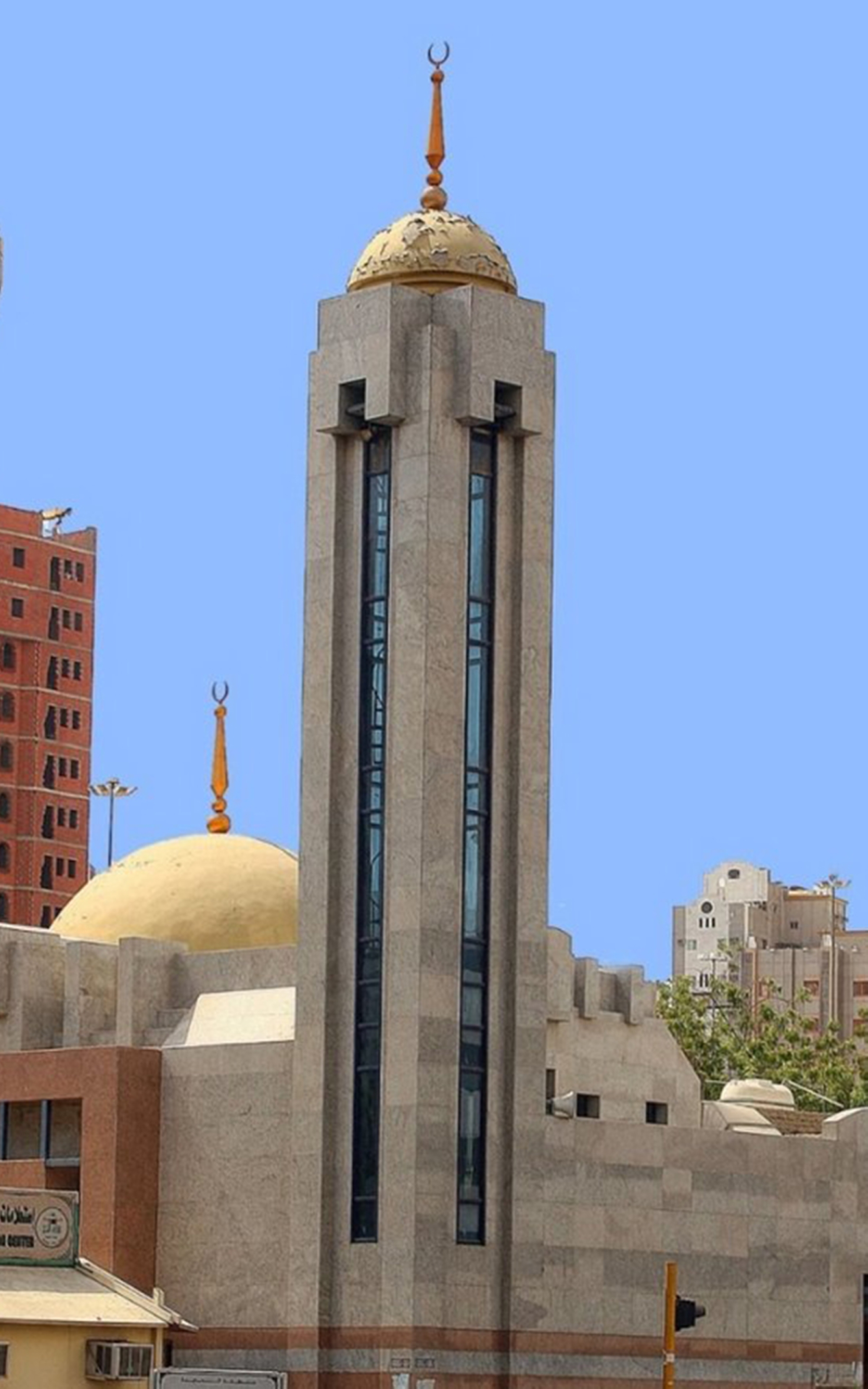
The historical significance of Makkah al-Mukarramah City
Despite its area of 3,004 km², Makkah al-Mukarramah is home to several sites of primary religious significance, bearing much of the historical value of Islam today. Chief among these are the holy sites of Muzdalifah, Mina, and Arafat, integral to the performance of the Hajj pilgrimage. Also notable is Ghar Hira, where the Prophet Muhammad (PBUH) used to meditate and where the Quran was first revealed to him. Additionally, there's Ghar Thawr south of Makkah, a significant location on the path of the Prophet's (PBUH) first migration, where he and his companion Abu Bakr as-Siddiq, may Allah be pleased with him, sought refuge to avoid persecution by the Quraysh. Furthermore, the Shi'b Banu Hashim was the site of the Prophet Muhammad's birth (PBUH) and his residence before the prophethood. In Makkah al-Mukarramah, there are numerous historical mosques associated with prophetic events, such as al-Jinn Mosque, al-Rayah Mosque where the Prophet planted his banner before the conquest of Makkah al-Mukarramah, al-Bay'ah Mosque, and al-Fath Mosque, which served as the headquarters for the Muslim army before the conquest of Makkah al-Mukarramah.
The geography of Makkah al-Mukarramah City
Location and borders
Makkah al-Mukarramah City is located in the central-western part of the Kingdom, between the latitudes nineteen and twenty-four north, and longitudes thirty-nine and forty-four east. It is nestled within Ibrahim al-Khalil Valley, surrounded by mountains, bordered by the eastern and western mountain ranges. The northern range consists of Jabal Falaq and Jabal Qaiqa'an, while the southern range includes Jabal Abi Hadida to the west, Jabal Kada to the south, and Jabal Abi Qubais in the southeast, followed by Jabal Khandama. It is approximately 330 m above sea level and is approximately eighty km away from the Red Sea.
To the north, it is bordered by al-Jumum Governorate, which is the closest to the city of Makkah al-Mukarramah among the governorates in the province. To the east lies Taif Province, to the west is the Red Sea, and to the south is al-Lith Governorate. Despite Jeddah Governorate's connection to Makkah al-Mukarramah, serving as the main air gateway to the city, they do not share borders. However, Jeddah Governorate is approximately seventy-three km away from Makkah al-Mukarramah, eighty-seven km from Taif, 450 km from al-Madinah al-Munawwarah, and 990 km from the capital, Riyadh.
Growth and urban expansion were primarily concentrated in the vicinity of the Grand Mosque until the early twentieth century. Subsequently, the city and its urban area expanded beyond the boundaries of the Grand Mosque. Nevertheless, Makkah al-Mukarramah has retained its oldest demarcation of boundaries to date, known as the sanctuary borders, referred to as Ansab al-Haram, established by the Prophet Ibrahim (PBUH). Currently, these boundaries are marked by 1,104 markers surrounding the four directions of Makkah al-Mukarramah and are limited to Muslims within its vicinity.
Climate of Makkah al-Mukarramah City
Due to its location at the northern edge of the tropical region and its distance from large bodies of water, Makkah al-Mukarramah is characterized by globally high average temperatures. The annual average temperature ranges from 29.9°C to thirty-one °C. In summer, it experiences dryness and intense heat reaching up to forty-eight °C, while winters are moderate, with temperatures dropping to around eighteen °C. Additionally, it is characterized by slow air movement due to its location in the transitional mountainous region between the mountain range and the coastal plain of the Red Sea, surrounded by Sarawat Mountains.
Geographically, the location and topography of Makkah al-Mukarramah, along with variations in atmospheric pressure centers, play a significant role in wind patterns. According to studies conducted on Makkah al-Mukarramah, winds blowing over the city come from three directions: the northern direction, which is hot and dry in summer and warm in winter; the northwestern direction, dry and humid in summer and rainy in winter; and the southwestern direction, which brings seasonal rainfall.
The average normal wind speed in Makkah al-Mukarramah ranges between four and 4.5 kn/h. The highest recorded average wind speed reaches thirty-six kn, equivalent to 66.7 km/h, while the lowest recorded average speed is three kn, or 5.6 km/h.
As for rainfall, Makkah al-Mukarramah is known for its low precipitation, which usually results from the northwesterly or southwest monsoon winds. The average annual rainfall in Makkah al-Mukarramah ranges between twenty-five and eighty mm.
The average humidity in the city of Makkah al-Mukarramah is low due to its inverse relationship with temperature and its dry desert nature. Makkah al-Mukarramah has recorded its highest humidity level at 57 percent, while the lowest humidity level was recorded at 32 percent, according to official records based on climatic standards.
Demographics of Makkah al-Mukarramah City
The population of Makkah al-Mukarramah is approximately 2,427,924 people, according to the 2022 Saudi census. It ranks third among four cities in the Kingdom with a population exceeding one million. Makkah al-Mukarramah serves as a global population center, with an average of around twenty-one million visitors annually. It is a dual-function city, serving both an internal population within its urban area and an external population consisting of seasonal visitors. Its population doubles during the Hajj season, resulting in the highest population density in the world during that time. Within its boundaries, Makkah al-Mukarramah accommodates around four million people, equivalent to the population of the Republic of Ireland as of the 2018 census.
The high seasonal population density governs urban planning in Makkah al-Mukarramah, with large parts of the central area surrounding the Grand Mosque being transformed into zones designated for serving and accommodating Hajj pilgrims, Umrah performers, and visitors. Urban sprawl has extended into rural areas away from high-density areas, leading to new social concentrations aimed at accommodating Hajj pilgrims and Umrah performers.
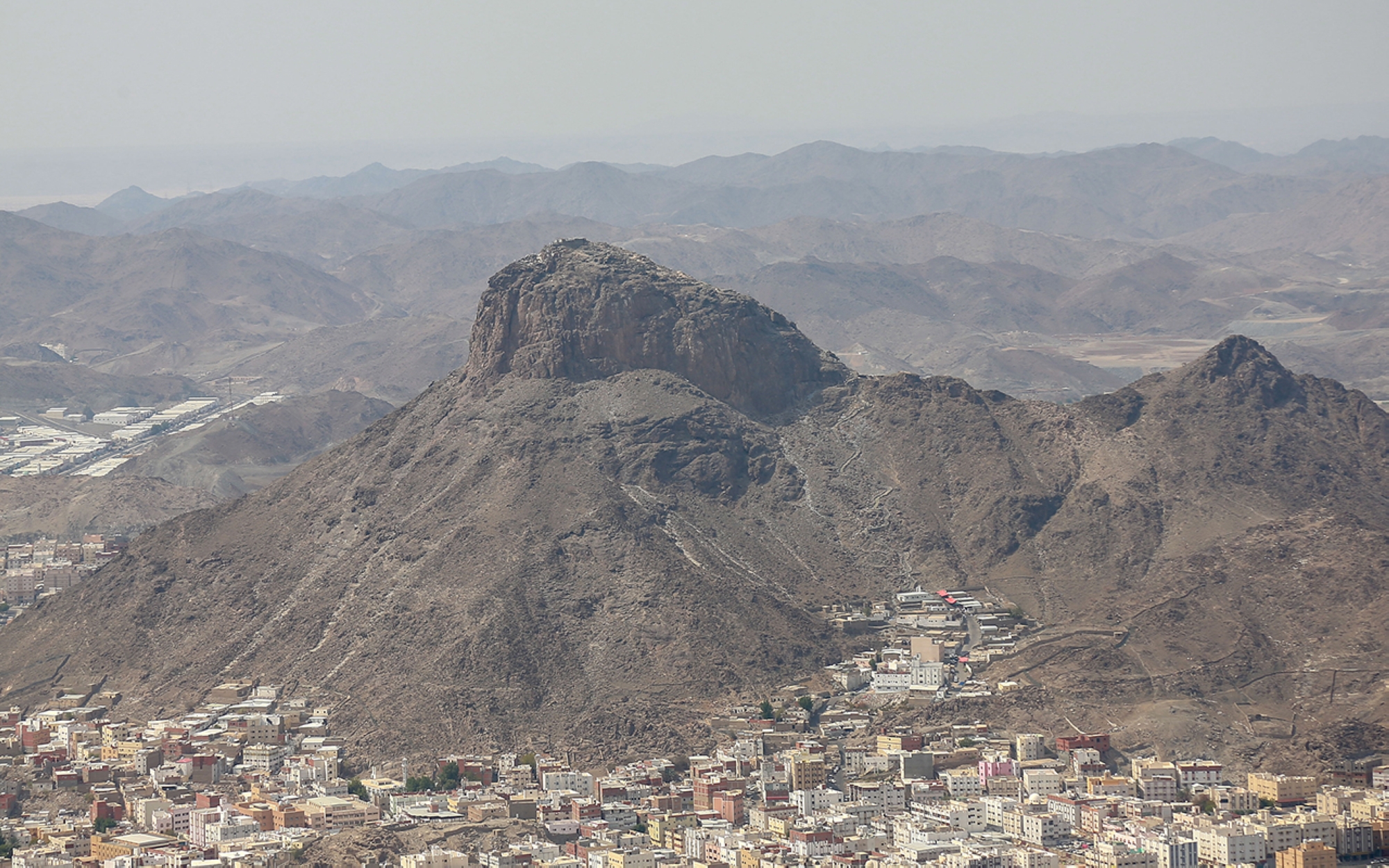
Topography of Makkah al-Mukarramah City
The nature of Makkah al-Mukarramah is considered one of the most challenging geological formations, with most of its rocks being volcanic. Its terrain varies between hills, mountains, and valleys, divided into three sections: the western section, with elevations ranging from two hundred m to 250 m, and some mountain peaks reaching up to four hundred m above sea level. The central section has an elevation of about three hundred m and includes historic mountains such as Jabal Thawr, reaching approximately 759 m, Jabal Qaiqa'an with a height of 427 m, Jabal Khandama rising to 420 m, and Jabal Abi Qubays at around 372 m. The "eastern section" rises to over four hundred m above sea level, hosting mountain peaks exceeding eight hundred m, including Jabal al-Tariqi, the highest peak in Makkah al-Mukarramah and the holy sites mountains, located east of Mina, reaching approximately nine hundred m in height.
Pre-Islamic era artifacts
Cairns "stone structures"
Stone structures, known as "cairns," have been found in the north of the city of Makkah al-Mukarramah and on the slopes of the mountains extending between Makkah al-Mukarramah and al-Lith. They are characterized by a sharp peak resembling a stake. Cairns are scattered throughout Makkah al-Mukarramah Province at the base of mountains, along their slopes, and on top of terrace formations, exhibiting various architectural forms. Some are enclosed by circular stone walls, while others have distinct walls or are associated with stone circles, ring walls, or sharp peak features.
Rock art
Rock art has spread across wide areas in the city of Makkah al-Mukarramah, found in various locations including al-ʽUsaylah, Arafat, al-Mughmas, al-I'tawa, Dwedah, Ain Shams, Jabal Adhal, al-Mahawi, Wadi al-ʽUsaylah, and the area of Dhi Majaz Souq. These sites comprise a collection of plateaus with Islamic inscriptions carved into their rocks, most of which are undated. Only two inscriptions have been found with dates. The surrounding mountains in Makkah al-Mukarramah also contain drawings believed to date back to the first century BCE, reflecting the environmental and cultural conditions of that time. These drawings depict various local animals such as horses, camels, cattle, goats, and oryx, along with around sixteen drawings representing the sun or stars. Through rock art, one can discern the types of weapons used, the animals present during that period, hunting and combat techniques, as well as religious customs, traditions, and beliefs.
Tags (Wusum)
These are symbols or marks in the form of a straight or curved line, or in the shape of a circle or dot, historically used to demarcate tribal territories and identify their livestock. Many of these have been found in the city of Makkah al-Mukarramah and have been classified into several types based on their shapes. These include the crescent, bucket, sun, arches, teardrops, squares, and hammers, found in Dwedah; the hammer, skewers, and spindles found in Arafat and Dwedah; the column and chisel, the former found in Arafat and the latter executed on a rock in Arafat; the circle, dots, and triangle found in al-ʽUsaylah; the symbol of life found in al-Mughmas; and the circle symbol found in al-Mughmas and Dwedah.
Thamudic inscriptions
This type of inscription appeared throughout the province, whether on the coast, Tihama, Sarat, or desert. The number of these inscriptions increased in an initial survey to seventy Thamudic inscriptions, some of which are unreadable due to erosion. These inscriptions are distributed in the following locations: Wadi al-ʽUsaylah, Dwedah, and Malkan. Malkan is a valley south of Makkah al-Mukarramah, currently traversed by a road used by non-Muslims heading towards Taif. It contains several mountains with inscriptions in Thamudic and Hijazi scripts. These Thamudic inscriptions were written in two styles: vertical in some locations and horizontal in others. Additionally, individual inscriptions were observed in some locations and within rock drawings at other sites.
Two types of scripts were found in Makkah al-Mukarramah Province: The Thamudic script and the Southern Musnad script. Some inscriptions of this script were discovered at several sites along the trade convoys routes, whether in Tihama, Sarat, or nearby. Additionally, the southern Musnad script inscriptions were also found.
Islamic era artifacts
Historical landmarks
Al-Ju'ranah
Al-Ju'ranah is the place where the Prophet Muhammad (PBUH) entered into the state of Ihram for Umrah, and where he stayed for thirteen nights after the Battle of Hunayn. It is located northeast of Makkah al-Mukarramah, about twenty-nine km away. There, the Prophet divided the spoils captured from the Hawazin tribe after the conquest of Makkah al-Mukkaramah. There is a well in the area, and some early Islamic inscriptions are carved on the slopes of its mountains. It also houses a historic mosque where the people of Makkah al-Mukarramah perform Umrah. The mosque, located about twenty-four km from the Grand Mosque, was renovated during the reign of King Fahd Bin Abdulaziz Al Saud in a modern style. It covers an area of approximately 430 m² and can accommodate up to one thousand worshippers.
Hunayn
It is currently called 'al-Sharai' and it is a valley that flows from the mountains of Tad and al-Tandab, located about twenty-six km east of Makkah al-Mukarramah, and about eleven km from the boundaries of the Grand Mosque via Najd route. It is located at the highest point of the Arnah Valley, near Dhi al-Majaz to the north, and it extends west towards the mountains of Lubn and Kanthil, with its upper part called al-Sadr and its lower part called al-Sharai. One of its tributaries is a valley called Yadaan.
Dar al-Arqam Bin Abi al-Arqam al-Makhzumi
It is the first house where the Prophet Muhammad (PBUH) gathered with his companions who embraced Islam. It is located on the right slope of Jabal Safa, in the area below the royal palaces. It was named after Abu Abdullah Asad Bin Abdullah Bin Umar Bin Makhzum, who was known in the past as al-Arqam Bin Abi al-Arqam al-Makhzumi. It is also called Dar al-Islam because it embraced the Islamic call and al-Mukhtaba' because Prophet Muhammad (PBUH) sought refuge there with a group of Muslims when the Islamic call was secretive. It is also known as Dar al-Khizran and Dar al-Arba'een.
Ghar Hira
It is the cave where the Prophet Muhammad (PBUH) used to worship, and where Jibril (PBUH) descended upon him. It is located northeast of Makkah al-Mukarramah, on the summit of the mountain, and contains some early Islamic inscriptions from the sixteenth century.
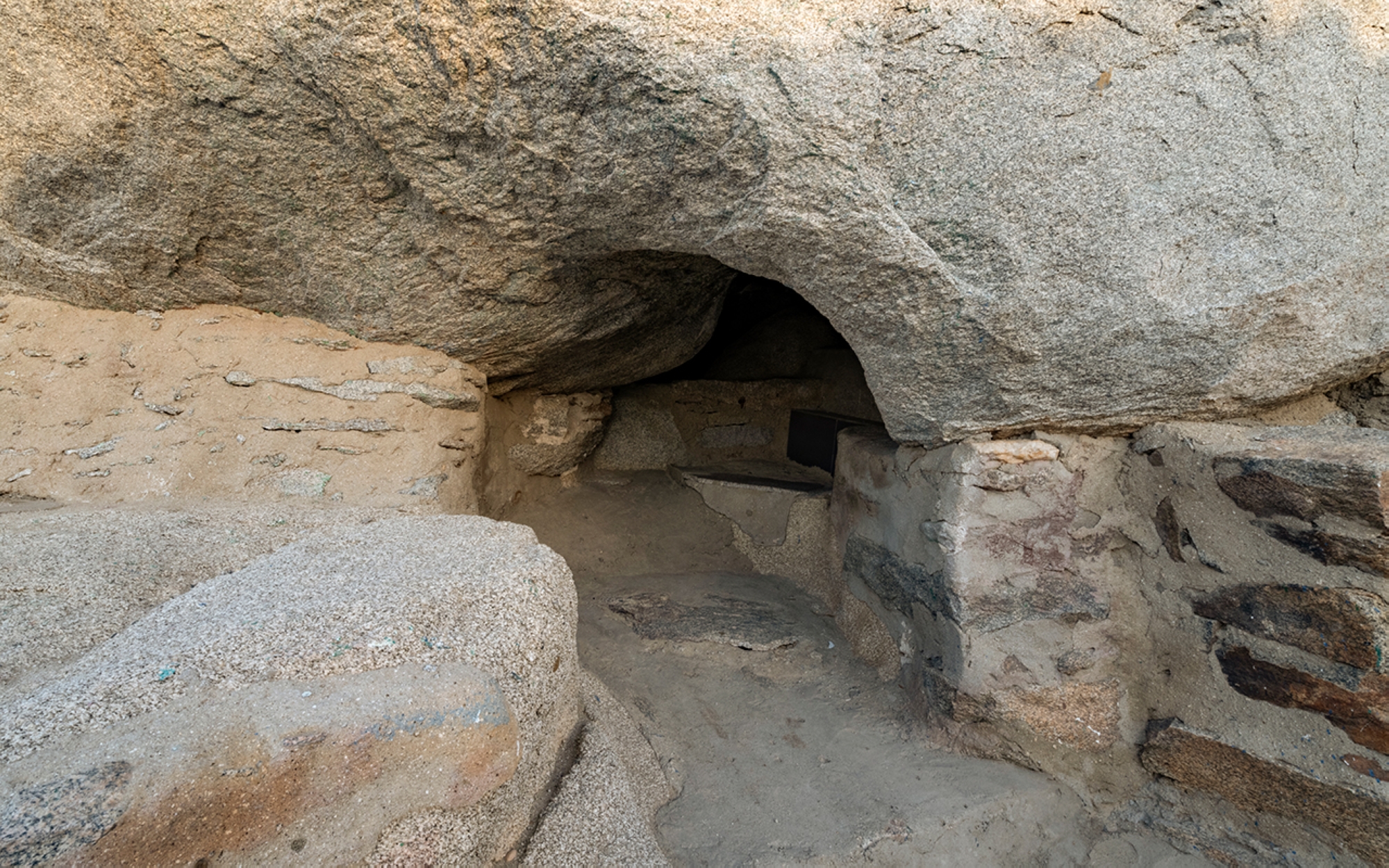
Ghar Thawr
Ghar Thawr is located south of Makkah al-Mukarramah, on the summit of Jabal Thawr, also known as 'Jabal Akhal'. The mountain's height reaches approximately 760 m. At the base of the mountain, facilities were established to assist and guide pilgrims and visitors during their ascent and descent, as well as to answer their inquiries.
Archeological sites
Jabal al-Shu'ara
It is located on the northeastern border of Arafat, and at its base, there are brown rocks engraved with rock drawings, inscriptions, and names of some figures, including the name of the guardian of al-Kaaba al-Musharrafa, Mus'ab Ibn Shaybah. Also, there is the site of the Khalifa Stone, located on the right as one comes from Arafat to Muzdalifah, which includes a large rock with inscriptions dating back to the seventh and eighth centuries.
Khalid Bin Abdullah Al Usaid Path
From the valleys of Makkah al-Mukarramah, it is located in the area of pilgrimage routes coming from Iraq, Syria, and Yemen, currently known as 'Wadi al-ʽUsaylah'. There, sixty early Islamic inscriptions have been found. Among these inscriptions are the names of some Islamic figures, such as Mohammed Bin Abdulrahman Bin Talha and Mohammed Bin Abdulaziz Bin Jurayj. Additionally, the remains of an extinct hamlet were discovered in this area.
Dwedah
One of the richest sites of rock art in Makkah al-Mukarramah Province, it is a small path containing rocks inscribed with Thamudic script, albeit scarce, and Hijazi script. These inscriptions date back to the seventh, eighth, and ninth centuries. Additionally, some animal drawings and various geometric shapes, along with pre-Islamic inscriptions, have been found in this area.
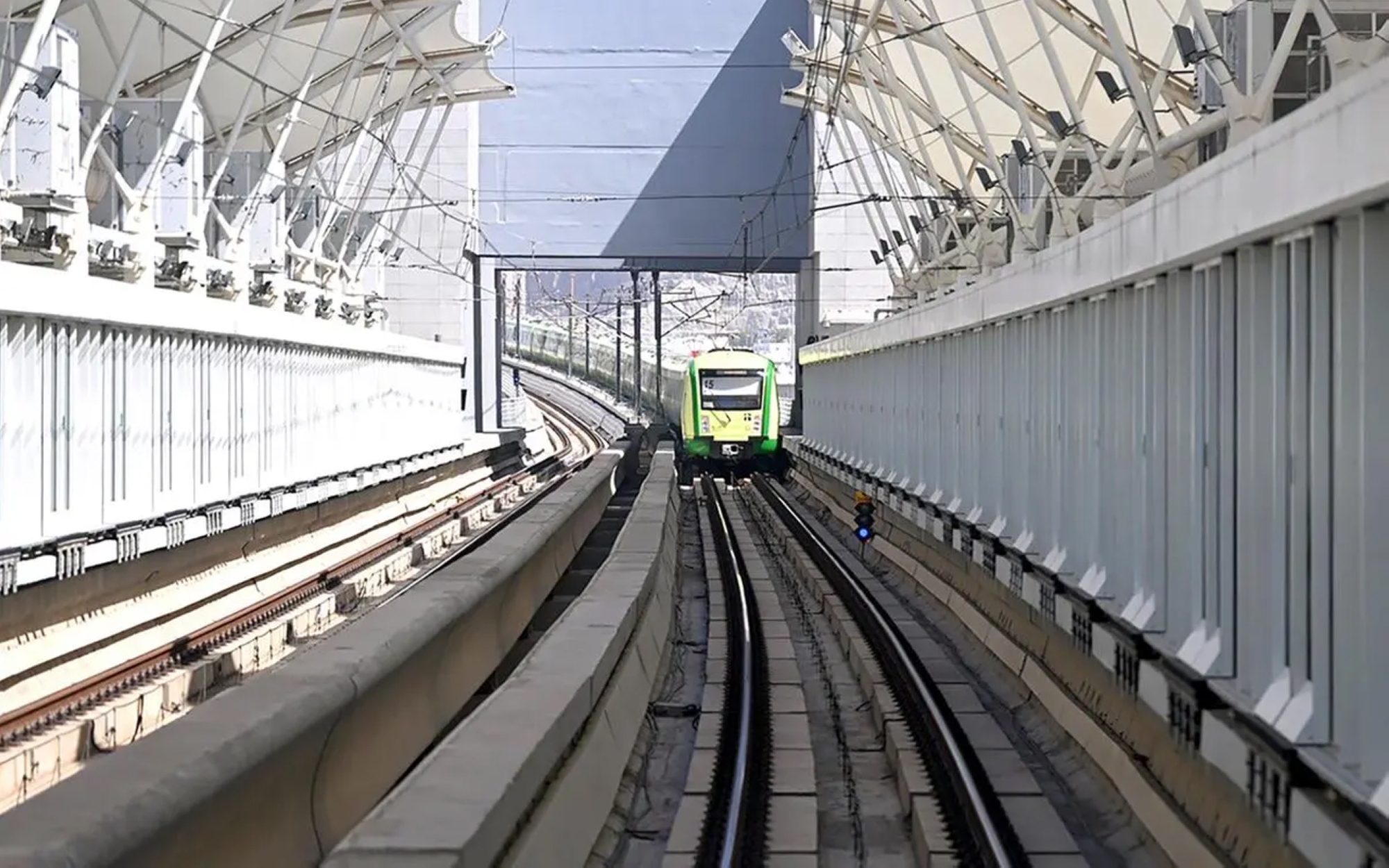
Transport in Makkah al-Mukarramah
Al-Mashaaer al-Mugaddassah Metro Line
It is a railway line that operates only during the Hajj season, serving the pilgrims of the Grand Mosque. It is considered one of the most important modern means of transportation used to transport pilgrims during the Hajj season. It connects Makkah al-Mukarramah to the holy sites, starting from Mount Arafat, passing through Muzdalifah, and ending at the Jamarat Bridge in Mina. Its first journey started in 2010, and its operation was assigned to the Saudi Arabia Railways 'SAR', starting in 2019, by a decision from the Council of Ministers. Al-Mashaaer al-Mugaddassah Metro Line operates seventeen trains, with a total capacity of 72,000 passengers per hour. Each train has a capacity of three thousand passengers. The train stops at nine stations and operates on a track with automated operating systems. Its length is about eighteen km, and its speed reaches up to eighty km/h. Al-Mashaaer al-Mugaddassah Metro Line project was awarded the "Franz Edelman Award" as the best applied operational research. It also received the international "FIDIC" award for its excellence in improving living conditions and protecting the environment from pollution caused by car emissions.
Haramain High-Speed Railway
It is an electric train that connects Makkah al-Mukarramah Province to al-Madinah al-Munawwarah Province, passing through Jeddah Governorate and the King Abdullah Economic City in Rabigh. It serves as a fast and safe mode of transportation for citizens, residents, pilgrims, and visitors to the Prophet's Mosque. Its first journey started in 2019 when the official launch of the project was inaugurated by the Custodian of the Two Holy Mosques, King Salman Bin Abdulaziz Al Saud.
Haramain High-Speed Railway extends from Makkah al-Mukarramah to al-Madinah al-Munawwarah over 450 km. It consists of thirty-five trains, thirteen cars, and 417 seats, with an annual capacity to accommodate sixty million passengers. The train is considered the fastest rail transport in the Middle East, operating at 350 km/h. The journey between Makkah al-Mukarramah and al-Madinah al-Munawwarah takes two hours and forty-five minutes, while the distance between King Abdulaziz Airport in Jeddah and al-Madinah al-Munawwarah takes two hours.
Haramain High-Speed Railway stops at five stations, all of which are expandable in the future: al-Madinah al-Munawwarah station, which is about seven km away from the Prophet's Mosque in the Knowledge Economic City, Makkah al-Mukarramah station, about three km away from the Grand Mosque in the Rusaifah District, and two stations in Jeddah, the first in the Sulaymaniyah District, and the second at King Abdulaziz International Airport. Additionally, there's a station in King Abdullah Economic City near King Abdullah University of Science and Technology, at the city entrance. Each station includes arrival and departure halls, a mosque, a civil defense center, a helipad, platforms for trains and passengers, short-term and long-term parking lots, VIP lounges, shops, restaurants, and cafes.
The General Syndicate of Cars
It is the entity responsible for regulating the companies providing transportation services for Hajj pilgrims and Umrah performers in the Kingdom. It works to provide organized transportation services equipped with modern means suitable for transportation, within safety standards and environmental protection measures. It was established on March 19, 1953, and from the start of its operations until 2019, the number of pilgrims transported through it reached about 73.5 million pilgrims.
On July 18, 2019, the Ministry of Hajj and Umrah launched the Transportation Information Center program, which is one of the programs of the General Syndicate of Cars aimed at leveraging technology. It involves automating the monitoring and processing of reports, including several levels of performance indicators, facilitating rapid monitoring of buses, their routes, duration of transportation, and waiting times. The syndicate includes two projects: the entrustment center project on the Madinah-Makkah highway, and the entrustment center project on the Madinah-Makkah Two highway.
Dhaif Platform
It is an electronic platform used to request transport buses and enables tracking of their locations. It was established by the General Syndicate of Cars with support from the Ministry of Hajj and Umrah. The number of its employees during the seasons reaches up to three thousand employees. The platform went through three stages: the study and planning stage, the construction stage, and the operational stage. It allows users to submit service requests, schedule, operate, and monitor the transportation of pilgrims in an integrated manner. It works to provide quality and digital services for administrative operations, control, and scheduling for seventeen thousand buses operating in the holy sites, serving around two million pilgrims. Dhaif platform has allocated three smart applications to serve eight user categories, which are: Bus Guide, Warehouse Manager, Operations Inspector, Operations Manager, Service Groups, Enterprise Manager, and Transfer Supervisor.
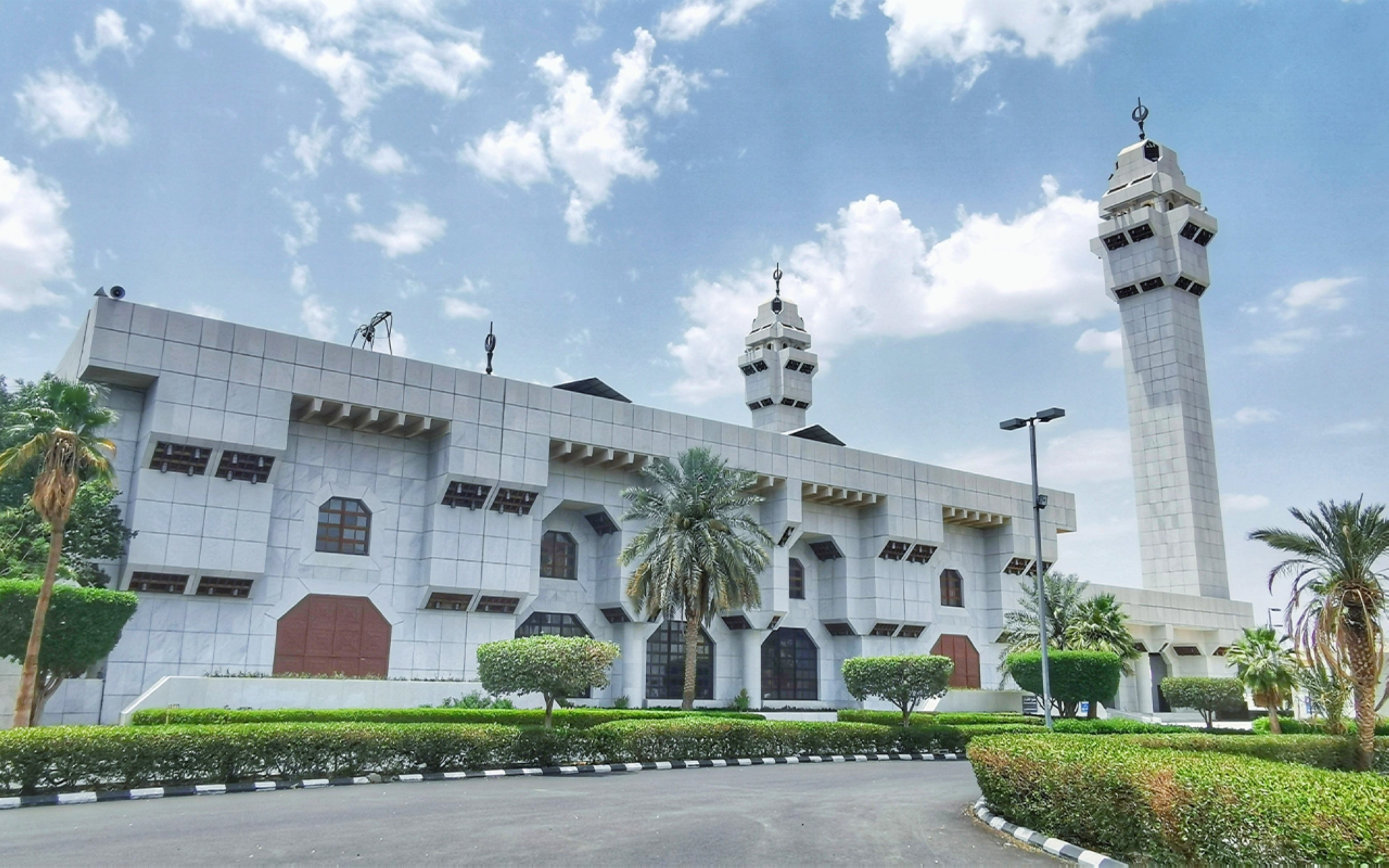
Religious landmarks in Makkah al-Mukarramah
Historical mosques
Bay'ah Mosque
It is the place where the Prophet Muhammad (PBUH) met with the Ansar to pledge allegiance to him and migrate to al-Madinah al-Munawwarah. It was established by Abu Ja'far al-Mansur in 761 at the location of the Second Pledge at al-Aqabah. Located three hundred m from al-Aqabah Stoning Site, below the valley of Mina, it is known as "Bay'ah Mosque" or "al-Aqabah Mosque."
Al-Ijabah Mosque
Located in al-Maabdah District in the heart of Makkah al-Mukarramah, it is one of the historical mosques in Makkah al-Mukarramah. It has undergone several modifications, with the latest being in 2001, when it was completely rebuilt. Two dated inscriptions were found on one of its walls facing the Qibla direction.
Al-Jinn Mosque
It is one of the closest mosques to the Grand Mosque, located in al-Hujun in the Ghazzah District near the Ma'lat Cemetery. It is named after the place where the Prophet Muhammad (PBUH) met the jinn. It is also known as the Mosque of the Guard because, during the Umayyad era, the guards of Makkah al-Mukarramah used to gather there and distribute themselves across its areas and neighborhoods.
Al-Taneem Mosque
Al-Taneem Mosque is located at the end of the Haram boundary towards the direction of al-Madinah al-Munawwarah. It is named so because it lies between two mountains, one called Naeem and the other called Na'im. It is also known as the Mosque of Aisha because it was built in the same place where Aisha (may Allah be pleased with her) entered into Ihram for Umrah during the Farewell Pilgrimage. Therefore, the people of Makkah al-Mukarramah enter into Ihram there. The mosque was built during the reign of the Caliph al-Mutawakkil in 854. However, it was demolished and then rebuilt during the reign of King Fahd Bin Abdulaziz Al Saud.
Exhibition of the Two Holy Mosques Architecture
It is an Islamic museum that houses many ancient and rare artifacts from the Grand Mosque and the Prophet's Mosque, in addition to inscriptions, architectural elements, rare Qurans, manuscripts, and photographs. It was opened on January 31, 2000, in Umm al-Joud District, near the King Abdulaziz Complex for Manufacturing the Kaaba Kiswa. The exhibition area covers approximately 1,200 m² and consists of seven halls, each dedicated to a specific type of exhibit.
Hira Cultural District
It is a cultural and tourist landmark located next to Jabal Hira, covering an area of over sixty-seven thousand m². It was inaugurated in 2023 and is overseen by the Royal Commission for Makkah City and the Holy Sites in collaboration with the Emirate of Makkah al-Mukarramah Province, the Ministry of Culture, the Ministry of Tourism, the Municipality of the Holy Capital, the Pilgrim Experience Program, and the General Authority for Awqaf. The district includes several facilities, including the Cultural Library specializing in the history of Makkah al-Mukarramah and Madinah al-Munawwarah and the Prophet's biography, the Revelation Exhibition narrating the story of the revelation to the Prophet Muhammad (PBUH), a museum dedicated to the Quran, the first of its kind in Makkah al-Mukarramah, and the Saudi Coffee Museum, in addition to a garden, restaurants, and cafes.
King Abdulaziz Complex for Manufacturing the Kaaba Kiswa
One of the largest complexes for manufacturing silk and embroidery, specializing in weaving the Kiswa of al-Kaaba. The Kaaba's kiswa is replaced once every year during the Hajj pilgrimage. Located in Umm al-Joud District, it is equipped with the latest electronic systems, electrical devices, and mechanical equipment. Formerly known as the Factory for the Kiswa of the Holy Kaaba, it was renamed to King Abdulaziz Complex for Manufacturing the Kaaba Kiswa in 2018 by the order of the Custodian of the Two Holy Mosques, King Salman Bin Abdulaziz Al Saud.
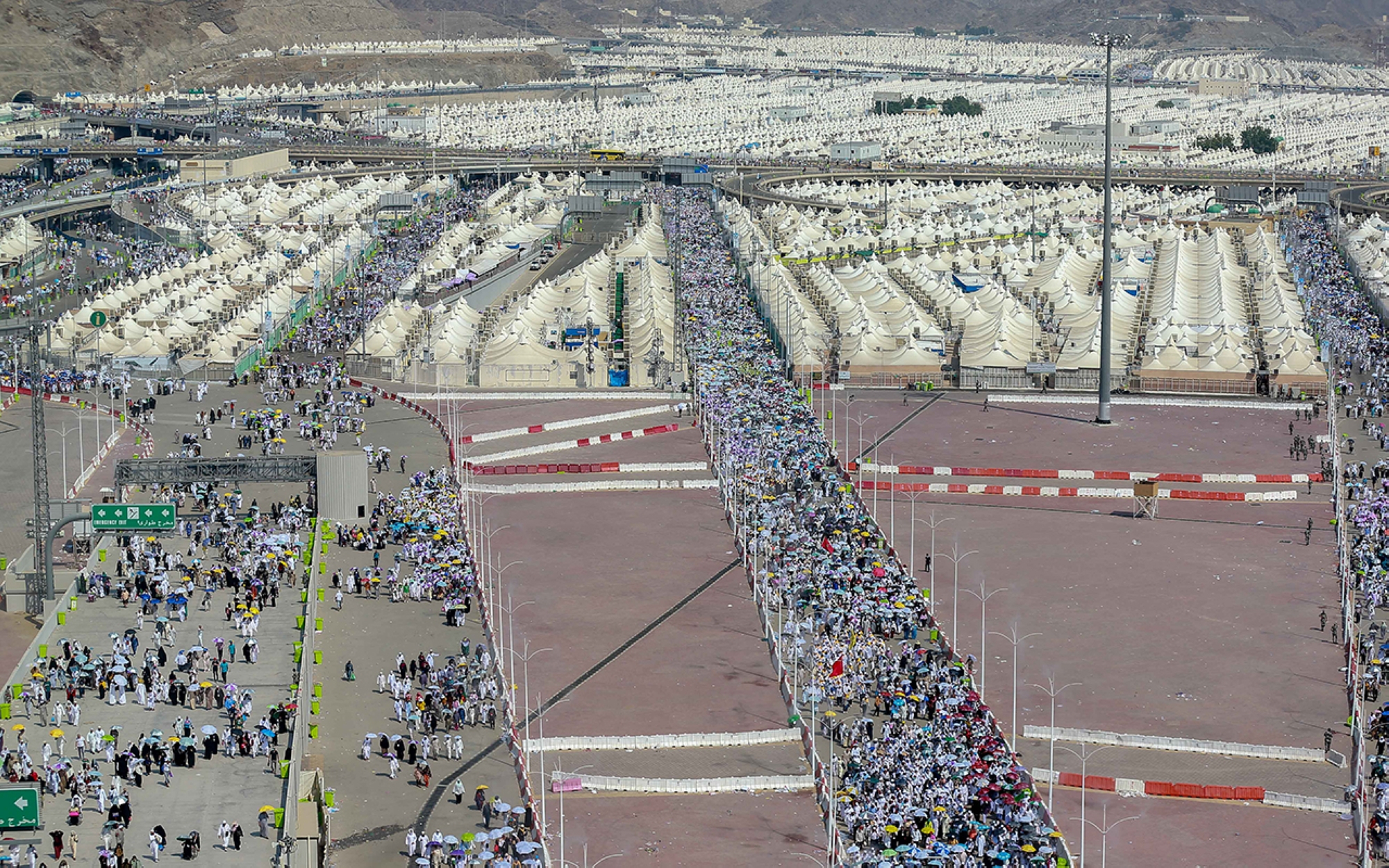
The holy sites in Makkah al-Mukarramah
Holy Site of Mina
It is the nearest holy site to the Grand Mosque, located approximately seven km away within the boundaries of the Grand Mosque, between Makkah al-Mukarramah and Muzdalifah. It is bordered by mountains to the north and south, and the valley of Muhassar to the direction of Muzdalifah. On Makkah al-Mukarramah side, it is bordered by the Jamrat al-Aqabah. The reasons for naming Mina are attributed to several narrations, the most prominent being Adam's wish for paradise there, and it is said to be a place where people gather, as Arabs refer to sites of people's gatherings as "Mina." It is the first of the holy sites Hajj pilgrims visit in Makkah al-Mukarramah, where Hajj pilgrims spend the eighth day of the month of Dhu al-Hijjah and the final days of Tashreeq. It is an uninhabited area except during the Hajj season. It contains the three Jamarat: Al-Sughra, al-Wusta, and al-Aqabah, along with several buildings designated for government and service agencies.
Among the Islamic landmarks found in Mina is "al-Khayf Mosque", located on the southern slope of Jabal Mina, near the Small Jamarat. It is also known as the Mosque of the Prophets because it is where the prophets prayed, as did Prophet Muhammad (PBUH). In 1987, the mosque underwent expansion and was equipped with various amenities such as carpets, lighting, and air conditioning. It now includes one thousand toilets and three thousand taps designated for ablution. The Ministry of Islamic Affairs, Dawah, and Guidance has designated the mosque as a venue for conducting educational activities and outreach programs for pilgrims, aimed at educating them about the rituals, rules, and significance of Hajj.
Muzdalifah site
It is the third station among the holy sites visited by Hajj pilgrims, where they spend the night. Staying there overnight is considered one of the obligations of Hajj. It is situated between the two holy sites of Arafat and Mina. It is called Muzdalifah, a name derived from people descending there at night. It is also said that people Muzdalifah (descend) toward the Grand Mosque.
The total area of Muzdalifah is approximately 963 ha, of which pilgrims use 682 ha. The holy site provides designated areas for accommodation, restroom facilities, water coolers, as well as medical facilities, guidance centers, communication services, organization of accommodation areas, and facilitation of traffic movement.
One of the Islamic landmarks in Muzdalifah is the "Masjid al-Mashar al-Haram," situated between the Namira Mosque in Arafat and al-Khayf Mosque in Mina. Its doors are open only on the night of the tenth of Dhu al-Hijjah. It is approximately five km away from al-Khayf Mosque in Mina and seven km away from the Namira Mosque in Arafat. During the Saudi era, it underwent expansion, with a length extending from east to west of ninety m and a width of fifty-six m. Its capacity was increased to accommodate twelve thousand worshippers. The mosque has three entrances: eastern, northern, and southern, and it is equipped with two minarets, each measuring thirty-two m in height.
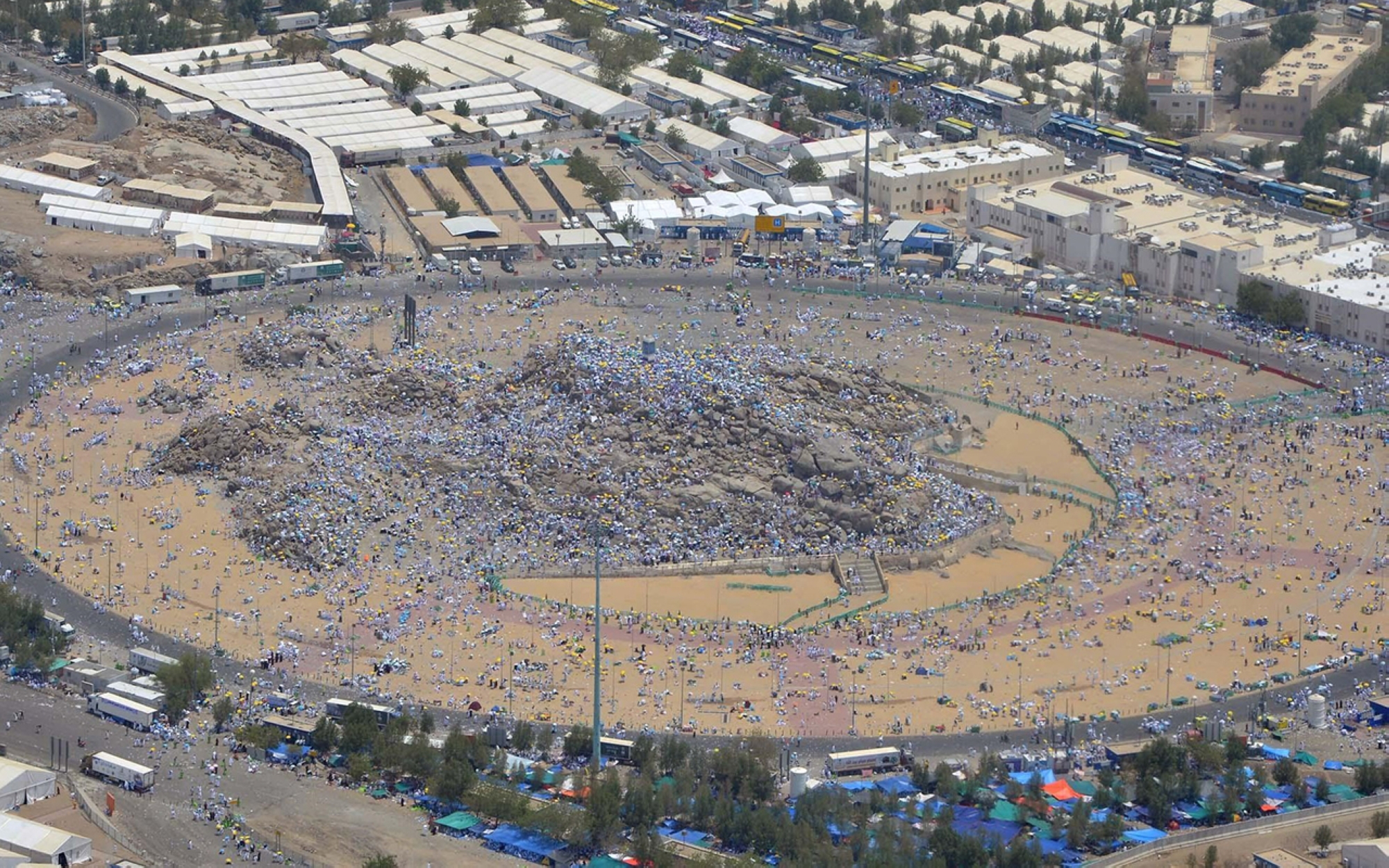
The holy site of Arafat
One of the holy sites visited by pilgrims in Makkah al-Mukarramah, located outside the boundaries of the Grand Mosque, on the road between Makkah and Taif, east of Makkah al-Mukarramah by about twenty-two km. It is ten km away from the Mina site and six km away from Muzdalifah site. It consists of a plain surrounded by mountainous curves, bordered by the Arnah Valley from several directions, and is devoid of inhabitants. It houses some governmental buildings dedicated to the activities of the Hajj season and several governmental headquarters for entities involved in Hajj-related work.
It includes several mountains, including Jabal Umm al-Ridum, Jabal Saad, and Jabal al-Rahma, which is one of its most famous landmarks. It is located east of Arafat, between the seventh and eighth roads. It consists of large black solid rocks and has many names, including Jabal al-Qarin, Jabal al-Dua'a, Jabal al-Rahma, Jabal Ilal (rhymes with Hilal), and Jabal al-Tawbah.
Arafat also includes the Nimra Mosque, one of the most important landmarks of the Arafat site. It was built at the location where the Prophet Muhammad (PBUH) delivered his farewell sermon during the Farewell Pilgrimage, in the middle of the eighth century, during the Abbasid Caliphate. It is the second-largest mosque in terms of area in Makkah al-Mukarramah after the Grand Mosque. It witnessed its largest expansion during the reign of the founder King Abdulaziz Al Saud. It is known by several names such as the Mosque of Prophet Ibrahim (PBUH), Arafat Mosque, and Arnah Mosque.

Jamarat
The Jamarat Bridge is located in the Mina area of Makkah al-Mukarramah, the Kingdom. It is frequented by the pilgrims to perform the ritual of stoning the three pillars during the Hajj days. It comprises al-Jamrah al-Sughra, al-Jamrah al-Wusta, and al-Jamrah al-Kubra, also known as al-Aqabah. The bridge is a five-story structure, each story reaching a height of approximately twelve m. It features three tunnels, eleven entrances to the pillars, and twelve exits in all directions. Additionally, it has a helipad for emergency helicopter landings, cooling systems, and mist spraying systems. Support services are also available. The capacity of the bridge is three hundred thousand pilgrims, and its cost exceeded SAR4.2 billion.
Since its construction in 1974, the Jamarat Bridge has undergone numerous development projects. These included expanding the bridge by forty m in width and adding two entrances from the eastern and western sides, as well as slopes near al-Aqabah from the northern and southern sides. In 1982, the length of the bridge increased by about 120 m and its width by twenty m. This was followed by another expansion in 1987, where the width of the bridge reached eighty m and its length approximately 520 m. Five service towers were erected on the sides of the bridge, and directional signs, lighting, and ventilation systems were installed. The total area covered reached around 57,600 m².
Modifications to the Jamarat Bridge have continued over the years. In 1995, various alterations were made to its design and structure. Further modifications were carried out after ten years, including changes to the bridge's structure, adjustments to the pillars positioned at the site of the stoning of the devil, transformation of the basin shapes from circular to oval, installation of emergency exits, and the placement of directional signs linked to pilgrim camps. These signs feature informative messages in different languages, cautioning pilgrims against overcrowding.
Development projects in Makkah al-Mukarramah
Masar Destination
It is one of the largest engineering projects in Makkah al-Mukarramah, located five hundred m away from the Grand Mosque. It includes a pedestrian path extending over 3,650 m with a width of 320 m, connecting from the third ring road to the first ring road, and extending the pedestrian pathway to the courtyard of the mosque. The total area of the project exceeds 1.2 million m². The project aims to achieve the objectives of Saudi Vision 2030 by establishing an investment base with high standards, enhancing the quality of life for Makkah al-Mukarramah residents, and serving the pilgrims by facilitating access to and from the mosque, aiming to increase the number of Umrah pilgrims to thirty million by 2030.
In 2022, the completion rate of the infrastructure for Masar Destination exceeded 83 percent. It included five vehicle bridges, eleven pedestrian tunnels connected to nearby neighborhoods, service tunnels for water and electricity connections, a central cooling network, and a waste transport network. Additionally, there were thirteen bus stops and four buildings for parking, with a capacity for 5,700 cars. The initial inauguration of the destination is expected in 2023.
Rou'a al-Haram al-Makki
It is one of the projects of Rou'a al-Haram al-Makki Company, a subsidiary of the Public Investment Fund. The aim is to enhance urban development in the area surrounding the Grand Mosque by increasing its capacity to accommodate several visitors coming to the Kingdom to perform Hajj and Umrah rituals. It is projected that the number of visitors to Makkah al-Mukarramah will increase to thirty million by 2030. Additionally, the project aims to diversify the national economy by attracting investments and creating job opportunities. The project is scheduled to be inaugurated in 2024.
"Thakher" Development Project
It is one of the development projects in Makkah al-Mukarramah, located about 1.5 km away from the Grand Mosque. It covers a total area of approximately 309,000 m², with roads, squares, and sidewalks covering about one hundred thousand m², constituting 35 percent of the project's total area. The project aims to improve the efficiency of the road network, enhance traffic connections with nearby areas, provide green spaces, and create safe pedestrian pathways to the Grand Mosque. It includes housing for around 250,000 people, eight residential towers, eighty-five hotels, ten apartment towers, 39,000 rooms, as well as ten thousand parking spaces and commercial markets.
Libraries in Makkah al-Mukarramah
The Library of al-Masjid al-Haram
One of the oldest libraries in the Islamic world, it was established during the Abbasid era in 777, during the reign of the Abbasid Caliph Mohammed al-Mahdi. In 1938, it was named the Library of al-Masjid al-Haram by the founder King Abdulaziz Bin Abdulrahman Al Saud. It is affiliated with the Grand Mosque and is overseen by the General Presidency for the Affairs of the Grand Mosque and the Prophet's Mosque.
The Library of al-Masjid al-Haram in Makkah al-Mukarramah is located in the Batha Quraish District of Makkah al-Mukarramah, covering an area of 2,066 m². It is a scientific library consisting of thirteen floors, housing more than two hundred thousand books, including seven thousand rare books. It also contains university theses, newspapers, journals, Qurans, and books in Braille for the visually impaired. The library comprises twelve sections, including sections for training courses, indexing and classification, binding, microfilm photography, libraries for people with special needs, rare books, donations and exchanges, and a wing dedicated to the Two Holy Mosques. The manuscripts section houses 7,849 original manuscripts, 372 manuscripts written in languages other than Arabic such as Urdu, Turkish, and Persian, 31,476 digital manuscripts, and more than 2,756 photographed manuscripts. The number of manuscript indexes reached fifty-five volumes.
The library building houses numerous administrative offices, training, and meeting rooms, as well as a support center for information technology, scientific research, and the preservation of Islamic heritage. It also includes departments for publications and publishing, audio-visual production management, a support office for security and safety management, and another for sanitation and carpets management.
The Center of Makkah History
It is a center affiliated with the King Abdulaziz Foundation for Research and Archives (Darah), established in 2008 in Makkah al-Mukarramah City. It is dedicated to documenting the history of Makkah al-Mukarramah across various aspects including religious, scientific, social, and urban life. This is achieved through the collection of information from diverse sources such as books, manuscripts, studies, documents, pictures, maps, and oral narratives. The center also produces visual films, conducts research studies, organizes scientific meetings and exhibitions, and publishes peer-reviewed and non-peer-reviewed scientific journals in multiple languages. The center has also published several works related to the history of Makkah al-Mukarramah, including: the book "Scientific Life in Makkah al-Mukarramah (1703-1916)", the book "Endowments on the Two Holy Mosques Outside the Kingdom", the book "Maqam Ibrahim (PBUH)", two volumes titled "Our Two Sacred Arabian Cities", the book "Pilgrimage to Makkah al-Mukarramah from the Indian Subcontinent (1500-1800)", and the book "Makkan Documents (1634-1955)".
Related quizzes
Related articles
